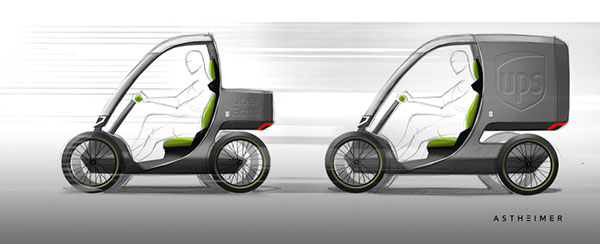Future mobility: The innovation space beyond the vehicles of today

The need for transport decarbonisation continues Professor David Greenwood of the Advanced Propulsion Systems team at WMG explains the need to invest in the infrastructure which could make micro-mobility safe and sustainable in the UK As we entered 2020, the automotive world was undergoing a technology transition faster than we have seen in the last hundred years – from petrol powered to electric cars which are IT connected. Covid-19 has accelerated this, forcing us to think carefully about why, whether and how we travel. Home working and travel restrictions were implemented in a matter of months. Walking and cycling enjoyed a renaissance, mass transit (buses and trains) were deserted and concepts like electric scooters, previously effectively banned by government, were pushed forward into regional trials. We now have the opportunity to focus on a different future. Our actions over the next three to five years can be aligned to a 20 to 30 year vision which delivers better air quality, zero net carbon emissions, healthier lifestyles, profitable industries and high quality employment. The transport sector is pivotal to improving our environmental and economic future. If we are to deliver continuing economic growth for the UK, it will be essential to develop connected, green solutions across multiple modes of travel – from trains, planes and cars to boats, bikes and scooters.The UK Government’s ‘Road to Zero’ strategy sets out a pathway for decarbonising transport and consultation is now underway regarding banning sales of new non-electric cars, including petrol, diesel and hybrid vehicles from 2035. This needs to happen at a time when the automotive industry is least able to invest in innovation due to the triple challenges of electrification, post-Brexit trade rules, and a sales slump. Innovation is crucial to bring sustainable technologies to the market at an affordable cost and in a way which meets all users’ needs. Approaches to mass transitWe need to think about modal shift in a different way – mass transit in buses, trams and trains is one way to deliver low carbon transport, by using a heavy vehicle to transport many people. Another is to look again at micro-mobility – the use of smaller vehicles to transport a single person, especially for local journeys Statistics indicate that use of bicycles, e-bikes and motor bikes for instance have been significantly higher post-covid, and that some migration from public transport to private cars is likely. “how do I look when using this” can also have as much of an impact on uptake, as price or technical capability. What is micro-mobility?Micro-mobility is about using smaller, lighter and more efficient vehicles to achieve short journeys. It could include hoverboards, bikes, e-bikes, scooters, mopeds, motorcycles and small four wheel vehicles (like the Renault Twizy) – technically referred to as L-Category vehicles. For short journeys, these can be time-efficient, cost effective and very low energy consumption, reducing congestion and parking problems. These can be municipal (e.g. Boris bikes) or privately owned. Where powered, they are usually good candidates for electrification.Cities around the world have taken very different approaches with very different results. Some (like San Francisco) could be likened to the “wild west” of scooters and bikes, with thefts, littering, dumping and road accidents – others (like Berlin) have put regulation in place and seen the benefits of that.There are lots of key variables to consider around these new modes of transport, including elements such as age restrictions, licensing, insurance, lanes and road infrastructures, ownership and protective equipment.Regulation in this area hasn’t kept pace with technology and acts as a barrier. Vehicles such as hoverboards and electric scooters are currently classed as motor vehicles in the UK and are therefore illegal to ride on either the road or pavement. Electric assisted bikes are classed as bicycles, although the difference between these and electric mopeds is becoming more blurred.Adopted and applied correctly, these forms of transport could have real benefits, but played badly we could result in safety and sustainability problems similar to those in San Francisco. Vehicle categoriesThe smallest examples of micro-mobility are self-balancing unicycles and hoverboards, which are small enough to carry on a bus or into the office. These are often first and last mile solutions in conjunction with public transport, but currently illegal on pavements, cycle lanes and roads in the UK. Safe use of these could, in future, provide last-mile transport, and increase public transport ridership.Limited trials, on electric scooters, are currently being carried out for people with a provisional licence, and for rental fleets. Comparatively, France allows usage from 12 years old and use of privately owned scooters. Here, however, no infrastructure was enacted and scooters should ride in the main carriageway. Many concerns have been raised over safety.Bikes and e-bikes should use cycle lanes where possible, but the state of these in the UK is not as good as other European countries. The surfaces are often poor, lanes are often shared with pedestrians, and often end abruptly at road junctions, Petrol or electric mopeds are restricted to 28mph and can be ridden from 16 years old in UK with a licence, basic training, insurance and a helmet. These vehicles are not allowed on cycle ways, and therefore must be on the road (not motorways). Arguably such vehicles would be safer on “cycle lanes” at speeds <20mph where the main carriageway speed is >30mph.Petrol or electric motorcycles can be ridden from 17 years old in the UK with a licence, insurance and a helmet, and can be used on a main carriageway.Petrol or electric quadricycles require the same licensing and insurance as a car, however the vehicle type approval requirements, especially for crash protection, are much lower. Adapting behavioursThe public response to Covid 19 has highlighted that societal behaviours can be malleable and receptive in ways that were previously unthinkable. Sales and use of bikes and e-bikes have increased. Rental e-scooter trials have been accelerated, and there are also more electric motorcycles, with many more planned for release.If sustainability through micro-mobility is technically achievable at





